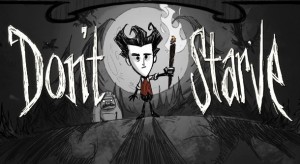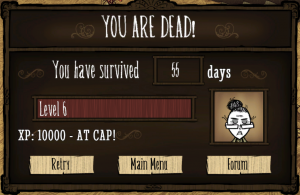Description
A surreal survival and an adventure game with a randomly generated open-world map. The objective is to survive as long as possible while weathering obstacles that the game throws at you.
Website
http://www.dontstarvegame.com/
Video
Personal Analysis
The Lens of Curiosity
Don’t Starve throws me into a surreal world full of dangers and surprises to survive in. No tutorials, no guides, no hints, leaving myself to answer my own questions. As I mindlessly click around in this unknown world, it is satisfying to learn every bit of survival knowledge including danger zones, hostile enemies, crafting recipes and an item’s use. My clicks became more purposeful after that. However, this also leads to more questions as I explore further unknown territories and face obstacles such as seasonal changes. To me, this repeated satisfaction of discovery forms the core experience when playing the game.
The Lens of the Weirdest Thing
The art style of Don’t Starve is telling of its quirky and eccentric nature. Many weird things accompany weird mechanics in the world of Don’t Starve. Understanding and utilising these oddities provide immense gratification as I have never experienced them before. Hence, it is always exciting to encounter these weird things in the game, and despite dying multiple times because of them, I still approach them at first sight. As Don’t Starve gave me the impression of being a weird game, these weird moments seem normal and coherent within my expectations of the game.
The Lens of Punishment
The punishment system in Don’t Starve can be frustrating and brutal. I feel frustrated whenever I die as my progress is completely reset with a new world and new conditions to adapt to. At first, this punishment seems unfair given that there were no tutorials or any guidance offered by the game. However, I later realised that this punishment system highlights the importance of survival and heightens the fear of death, which truly adds to the survival experience in Don’t Starve.
The Lens of Visible Progress
One of the most rewarding experiences in Don’t Starve is watching my base grow larger as I craft more equipment and buildings in my base. The base that I build is larger and more impressive each time I improve. This visual indicator of progress gives me a sense of accomplishment whenever I return back to base after a day’s hard work out in the world of Don’t Starve.
Elemental Tetrad Analysis
The mechanics of Don’t Starve aligns well with the game’s intention to stimulate my curiosity and encourage discovery. As you get better at surviving, the game will introduce new dangers to challenge your ability to adapt. Don’t Starve is hence well-balanced in the aspect of empowering and challenging the player. The game’s art direction, music and sound also complement the world of Don’t Starve. The quirky yet catchy background music changes to suit the theme and current state of the game. Every sound that the game produces, such as chewing sounds as I eat, contribute to the immersive yet unusual survival experience in Don’t Starve. The story of Don’t Starve also does a good job of telling me about my current plight while letting me discover the rest (as seen in game description), exactly like the game mechanics. The game’s use of a simple pseudo-3D world also promotes the game’s simplicity while maintaining the crucial art style for in-game assets.
Friend’s Analysis
The Lens of Curiosity
Like me, my friend also asked many questions when he played the game for the first time. Initially, he was amused by little interactions with the creatures such as being chased by an angry bee. He derived more satisfaction from these actions and interactions rather than his ability to survive. As time pass, his amusement from these interactions declined while he began to grow more frustrated with dying, since he had not invested in the survival aspect of the game. His curiosity is mainly targeted towards the combat system in Don’t Starve.
The Lens of Punishment
The punishment system in Don’t Starve was a total turn-off to my friend. He is irritated whenever he dies for unknown reasons, which is understandable given Don’t Starve’s harsh punishment system and lack of guidance. To make matters worse, he never bothered to find out the reasons for his deaths. As a result, he dies repeatedly for the same reasons, and it adds to his frustration.
The Lens of Fun
My friend clearly had minimal fun at the end of his Don’t Starve game session. His drop in excitement level shows through his increasingly dreary mouse movements and lack of expression. He only finds fun in the action aspect of Don’t Starve fight or flight combat system. During combat, my friend seem to be more focused and excited compared to exploration and base-building. Since he was not very interested in the aspect of survival, a huge part of Don’t Starve was not enjoyable to him.
The Lens of Visible Progress
This lens is lacking in my friend’s playthrough. His progress was minimal hence he had only a few buildings in his base. As a result, the satisfaction and feeling of accomplishment derived from this lens did not apply to him. Consequently, the lack of a progression indicator despite killing many creatures made him feel that his investment in the game was not rewarded. Eventually, he got bored of the game and refused to play it further.
Comparison Analysis

The Lens of Curiosity
This is perhaps one of the more crucial lens that Don’t Starve is based on. Both my friend and I had had many questions at the start which drive us to play the game. However, the type of questions we asked differed. I had wanted to find out how I could survive longer, whereas my friend had wanted more action from the game. As the main focus of Don’t Starve is survival, I am able to derive more satisfaction from the game compared to him since the game does not offer much in the action department. What we expect from the game and what the game provides in response to these expectations determine how much the game is “fun” to us. Therefore, it is important to know the type of game you are creating and the questions it answers towards your target audience.
The Lens of Punishment
It is tricky to balance between player punishment and reward. Don’t Starve’s punishment system motivates players such as myself that appreciate its difficulty and its unique rewards. However, for players such as my friend who want an easy and straightforward game, Don’t Starve can come across as an unforgiving and frustrating game. It is hence crucial to provide multiple levels of difficulty in order to cater to players who seek various levels of challenge.
The Lens of the Weirdest Thing
Making a game unique has a possible drawback of making it strange and off-putting. Being able to provide a different but relatable experience is the crux to creating a unique game. Although I find the game strange, I find the mechanics behind them interesting and not at all overwhelming. However, my friend did not appreciate Don’t Starve’s weirdness as much as I did, and I believe that this translates to lesser satisfaction on his part. Making a game special in its own way is important for it to stand out, but one has to ensure that the mechanics are still reasonable and not “out of this world” bizarre.
The Lens of Visible Progress
Being able to visually gauge one’s progression is tantamount for a player who invests long hours in a game. I felt rewarded when I saw my base develop in Don’t Starve, but my friend did not experience this satisfaction as he did not focus on his base’s improvement. Needless to say, he felt that his progression was stagnant and this made him lose interest in the game more quickly. Therefore it is important to give players some knowledge of progression in games to maintain and secure their interest. Such progress indicators also provide players with the feeling of accomplishment and satisfaction.






